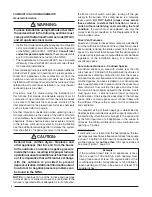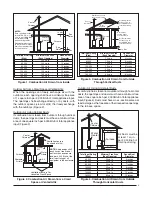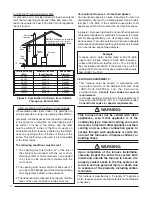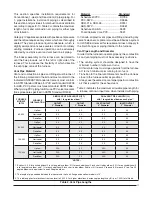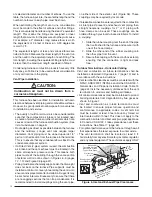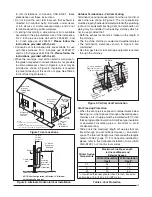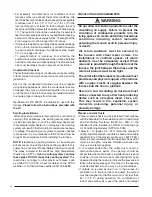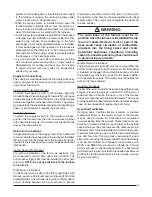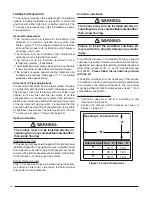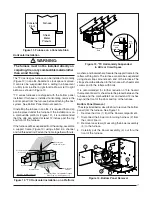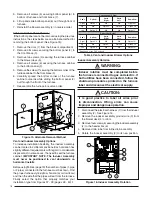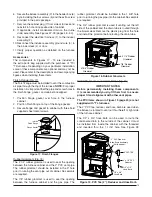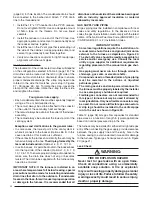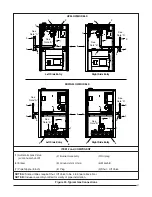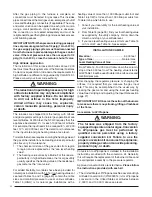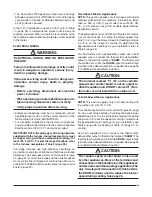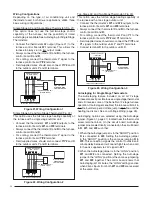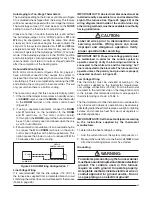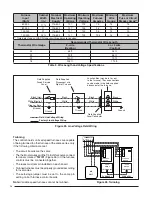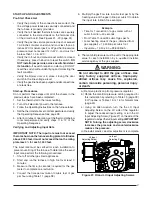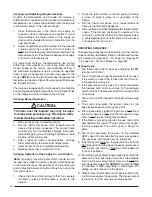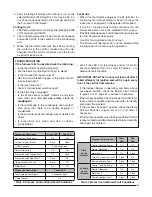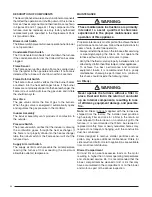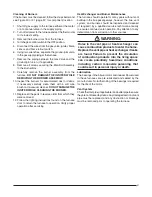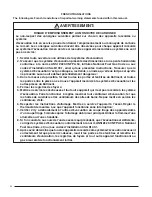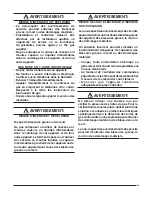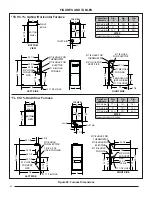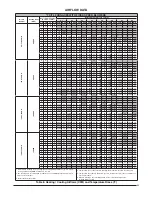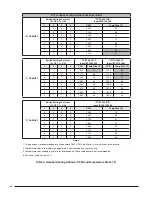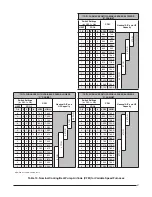
22
After the gas piping to the furnace is complete, all
connections must be tested for gas leaks. This includes
pipe connections at the main gas valve, emergency shutoff
valve and fl exible gas connectors (if applicable). The soap
and water solution can be applied on each joint or union
using a small paintbrush. If any bubbling is observed,
the connection is not sealed adequately and must be
retightened. Repeat the tightening and soap check process
until bubbling ceases.
IMPORTANT NOTE: When pressure testing gas supply
lines at pressures greater than 1/2 psig (14 inch W.C.),
the gas supply piping system must be disconnected
from the furnace to prevent damage to the gas control
valve. If the test pressure is less than or equal to 1/2
psig (14 inch W.C.), close the manual shut-off valve.
High Altitude Application
The installation of this furnace at altitudes above 2,000
feet must meet the requirements of the National Fuel Gas
Code or local jurisdiction. In Canada, the requirements for
high altitude are different and governed by CGA B149.1.
Please consult your local code authority.
WARNING:
The reduction of input rating necessary for high
altitude installation may only be accomplished
with factory supplied orifi ces. Do not attempt
to drill out orifi ces in the fi eld. Improperly
drilled orifi ces may cause fi re, explosion,
carbon monoxide poisoning, personal injury
or death.
The furnaces are shipped from the factory with orifi ces
and gas regulator settings for natural gas operation at sea
level altitudes. At 2000 feet, the NFGC requires that this
appliance be derated 4% for each 1000 feet of altitude.
For example, the input needs to be reduced 8% at 2,000
feet, 12% at 3,000 feet, etc. This deration is in reference
to the input rate and gas heating value at sea level.
To derate the furnace requires knowing the heating value of
the gas at the installation site. Heating values at particular
job sites vary for two reasons:
1. The chemical mixture of the gas varies from region
to region and is expressed as the “sea level heating
value”.
2. The heating value varies by altitude. For this reason,
particularly in high altitude areas, the local gas utility
usually specifi es the heating value at the residence’s
gas meter as the “local value”.
For added fl exibility, two tables have been provided for
natural gas installations with high or low heating values at
sea level. Tables 15 and 16 (page 40) contain the orifi ce
sizes and manifold pressure to use at various altitudes.
Table 15 (HIGH) is for natural gas installations with a
INSTALLATION EXAMPLE
Elevation:
................................................5,000 feet
Type of Gas:
.........................................Natural Gas
Local Heating Value of Gas:
............................750
From Table 14, fi nd 750 and follow down the column,
stop at the 5,000 feet row. The heating value listed is
LOW. Table 16 will be used to determine orifi ce size and
manifold pressure.
heating value of more than 1,000 Btu per cubic foot and
Table 16 (LOW) is for less than 1,000 Btu per cubic foot.
To determine which table to use:
1. Consult your local utility for the local heating value at
your installation.
2. From Table 14 (page 39), fi nd your local heating value
as supplied by the utility company. Follow down the
column and stop at your altitude level.
3. If your sea level heating value is HIGH, use Table 15
or if it’s LOW, use Table 16. See example.
After changing the regulator pressure or changing the
orifi ces, it is required that you measure the gas input
rate. This may be accomplished in the usual way, by
clocking the gas meter and using the local gas heating
value. See Verifying and Adjusting the Input Rate section
(page 27).
IMPORTANT NOTE: Observe the action of the burners
to make sure there is no yellowing, lifting or fl ashback
of the fl ame.
Conversion to LP/Propane
WARNING:
The furnace was shipped from the factory
equipped to operate on natural gas. Conversion
to LP/propane gas must be performed by
qualifi ed service personnel using a factory
supplied conversion kit. Failure to use the
proper conversion kit can cause fi re, explosion,
property damage, carbon monoxide poisoning,
personal injury, or death.
Conversion to LP/propane is detailed in the installation
instructions provided with the conversion kit. Generally,
this will require the replacement of the burner orifi ces and
the spring/stem assembly in the pressure regulator.
Approved conversion kits are listed below.
Please follow
the instructions provided with each kit
.
• The United States LP/Propane Gas Sea Level and High
Altitude Conversion Kit (P/N 904914) is for LP/propane
conversion in the United States at altitudes between
2,000 ft. and 10,000 ft. above sea level.

